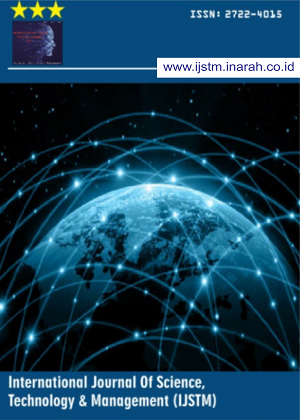Implementation Of Work Stress In Moderating Work-Life Balance And Flexible Work Arrangements For Job Satisfaction During The Covid-19 Pandemic
Abstract
Teachers as human resources in schools have demands that the implementation and work-life balance and flexible work
arrangement can be balanced and minimize work stress. The implementation of online learning systems that can make
teachers do work-life balance and flexible work arrangements should be able to reduce stress and increase job
satisfaction. But the reality in the field is that many teachers do not get job satisfaction. The purpose of this study was to
analyze the description and effect of work-life balance, flexible work arrangement, job satisfaction and job stress. The
object of this research is the State Senior High School PNS Teachers in Pematang Siantar City who have been certified as
many as 168 people. Data analysis techniques used are normality test, regression analysis, correlation coefficient and
determination and hypothesis testing. The test was carried out using the SPSS Statistic version 20 program. The results
showed are Jjb satisfaction, work-life balance, flexible work arrangement and work stress were in the answers with the
criteria of agree/satisfied. The practice of flexible work arrangements affects work-life balance. The results of the
regression have a positive influence between each variable. The results of the correlation coefficient analysis obtained a
strong and positive relationship. The results of hypothesis testing show a positive and significant effect. Work stress
variable is not a moderating variable. It is concluded that the application of work-life balance and flexible work
arrangements can increase job satisfaction and work stress is a debilitating variable.
Downloads
References
[2] Kementerian and P. dan Kebudayaan, “Kemendikbud Terbitkan Pedoman Penyelenggaraan Belajar dari Rumah,” 2020. https://www.kemdikbud.go.id/main/blog/2020/05/kemendikbud-terbitkan-pedoman-penyelenggaraan-belajar-dari-rumah.
[3] A. S. Andriyana and Supriansyah, “Konsep Work-Life Balance Terhadap Produktifitas Pegawai Yang Menerapkan Work From Home Pada Masa Pandemi Covid-19 (studi Literatur),” Ilmiah, Sumber Daya Mns., vol. 5 No. 1, pp. 1–11, 2021, doi: http://dx.doi.org/10.32493/JJSDM.v5i1.13138.
[4] S. Gusvita, “Pengaruh work-life balance terhadap kepuasan kerja pada guru wanita di madrasah aliyah negeri kota medan,” Skripsi, p. Sumaetra : Universitas Sumatera Utara, 2020.
[5] B. Arif and Y. A. Farooqi, “Impact of Work Life Balance on Job Satisfaction and Organizational Commitment Among University Teachers: A Case Study of University of Gujrat, Pakistan,” Int. J. Multidiscip. Sci. Eng., vol. 5 No. 9, pp. 24–29, 2014, [Online]. Available: https://www.researchgate.net/publication/324646756 Impact of_Work_Life_Balance_on_Job_Satisfaction_and_Organizational_Commitment_Among_University_Teachers_A_Case_Study_of_University_of_Gujrat_Pakistan.
[6] A. A. Fadhila and L. Wicaksana, “Sistematik Review: Fleksibel Working Arrangement (Fwa) Sebagai Paradigma Baru Asn Di Tengah Pandemi Covid-19,” Spirit Publik J. Adm. Publik, vol. 15, no. 2, p. 111, 2020, doi: 10.20961/sp.v15i2.44542.
[7] W. Parimita and U. Widyastuti, “Pengaruh Work Life Balance dan Stres Kerja Terhadap Kepuasan Kerja Pada Tenaga Pendidik (Dosen) Fakultas Ekonomi Universitas Negeri Jakarta,” Negeri Jakarta, 2015.
[8] L. M. Saleh, S. S. Russeng, and I. Tadjuddin, Manajemen Stres Kerja, Pertama. Yogyakarta: CV. Deepublish Budi Utama, 2020.
[9] Kadir, Statistika Terapan Kosep, Contoh dan Analisis Data dengan Program SPSS/Lisrel dalam Penelitian. 2015.
[10] Sugiyono, Metode Penelitian Kuantitatif, Kualitatif dan R&D. Bandung: CV. Alfabeta, 2017.
[11] Hardani et al., Metode Penelitian Kualitatif & Kuantitatif, Cetakan I. Yogyakarta: CV. Pustaka Ilmu, 2020.
[12] S. Arikunto, Prosedur Penelitian: Suatu Pendekatan Praktik, 6th ed. Jakarta: Rineka Cipta, 2016.
[13] M. Fayyazi and F. Aslani, “The Impact of Work-Life Balance on Employees’ Job Satisfaction and Turnover Intention; the Moderating Role of Continuance Commitment,” Int. Lett. Soc. Humanist. Sci., vol. 51, pp. 33–41, 2015, doi: 10.18052/www.scipress.com/ILSHS.51.33.
[14] K. Stefanie, E. Suryani, and A. Maharani, “Flexible Work Arrangement, Work Life Balance, Kepuasan Kerja, dan Loyalitas Karyawan Pada Situasi Covid-19,” J. Ilm. MEA (Manajemen, Ekon. dan Akuntansi), vol. 4, no. 3, pp. 1725–1750, 2020, doi: https://doi.org/10.31955/mea.vol4.iss3.pp1725-1750.
[15] K. Chandra Putra, T. Aris Pratama, R. Aureri Linggautama, and S. Wulan Prasetyaningtyas, “The Impact of Flexible Working Hours, Remote Working, and Work Life Balance to Employee Satisfaction in Banking Industry during Covid-19 Pandemic Period,” J. Bus. Manag. Rev., vol. 1, no. 5, pp. 341–353, 2020, doi: 10.47153/jbmr15.592020.
[16] L. N. Safitri and M. Astutik, “Pengaruh Beban Kerja Terhadap Kepuasan Kerja Perawat Dengan Mediasi Stress Kerja,” JMD J. Ris. Manaj. Bisnis Dewantara, vol. 2, no. 1, pp. 13–26, 2019, doi: 10.26533/jmd.v2i1.344.





























